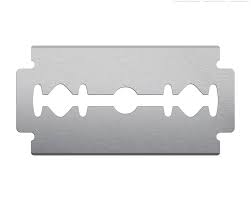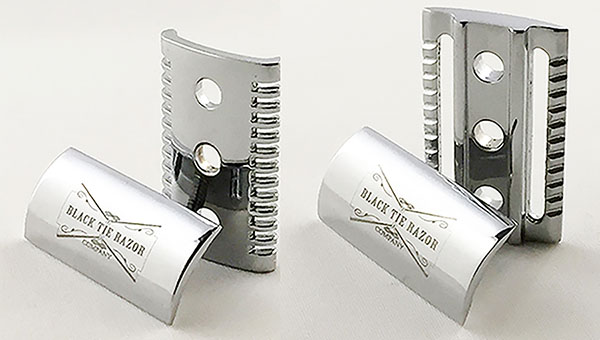Getting Started “The Razor”

Now that you know what wet shaving is and have decided you want to “get in the game” what’s next? Well, you have some decisions to make. What razor, what blade, what brush, what soap, etc. In today’s entry, let’s talk about the razor. The simplest and safest razor is the double edge safety razor (DE or DE safety). This type of razor uses one blade with 2 edges (one on each side) as seen here.
There are 3 main variations, 2-piece, 3-piece, and butterfly (or twist-to-open aka TTO) designs. BTRC razors are of the 3-piece variant consisting of a handle, base-plate, and cap. The cap and base-plate together make up the head. Handles vary in length, diameter, weight, contour, and texture but all serve the same purpose, a mounting point for the head and to hold while shaving. Handles and are a matter of personal preference. The head is where the rubber meets the road, or, where the blade meets the skin. This is where the real difference between DE razors lie. What makes a DE razor a “safety razor” is the guard or safety bar, the portion of the base-plate on the underside of the blade and prevents too much of the blade from coming into contact with your skin. There are many different guard designs but all basically fall into one of 2 categories, open comb (on left) and closed comb (on right).
As you can see, the open comb has open grooves and is generally more aggressive than the closed comb design. If you are new to wet shaving or have sensitive skin, it’s usually recommended that you start with a closed comb head. Aggressiveness is a relative term used to describe and measure a razor’s shave characteristics. Values ranges from mild, to medium, to aggressive (some use a scale of 1-x). But what determines a razors aggressiveness? There are 3 main components that will determine how aggressive a head is; blade angle, blade gap, and blade extension.
Blade angle refers to the angle of the blade in relation to the cap and base-plate. Looking at the cap from the short side, you will see that it’s curved in an arc. As the cap screws into the handle through the base-plate it forces the blade to bend. The greater the bend, the steeper the angle, the more aggressive the shave.
The second factor is blade gap. This refers to the distance between the safety bar and the blade. As the gap increases more skin is exposed to the blade, the more exposure, the more aggressive the shave.
The third factor in the aggressiveness equation is blade extension. This is a measure of the distance the edge of the blade extends beyond the plane between the edge of the safety bar and the edge of the top cap. This can be a negative or positive measure (exactly on the plane is 0 or neutral). The greater the number, the more aggressive the shave as more skin is exposed to the blade.
Mind you, these tolerances are measured in the hundredths or thousandths of an inch. A very small change in any one of these 3 aspects of the head geometry will alter the shave characteristics. There are sites on the Internet that have measured, calculated, and scored the aggressiveness of many different razors against each other if you would like to investigate further.
Here at BTRC we offer 2 head options – a closed comb and a slightly more aggressive open comb. We also offer a combo deal if you want to purchase both heads and it will save you a couple bucks over buying them individually. We strongly recommend the close comb for someone new to wet shaving but find most will move to the open comb over time as they learn how to shave using this technique.
We currently offer a solid stainless steel handle, model 30S, which weighs in at 64 grams, is 3.0” long and a stout 0.5” in diameter (shown). This handle is made in the USA exclusively for BTRC.
We have several other stainless steel handle options in the works which will be available in the near future. Thanks for reading, hope this helps as you begin your journey into the world of wet shaving.
Update: We now offer our model 40R handle, same stainless steel, 69 grams, 4" x 7/16"



